
The Lao word is Nalok, a variation on the Sanskrit word Naraka. The exact metaphysics I think are still in need of research but a historic understanding of these notions is fraught with a significant amount of intercultural contamination. Between Jesuit, Catholic, Protestant missionaries of the 1800s to the 20th Century, popular media, and the influence of Chinese and other Southeast Asian cultural concepts of the afterlife, the everyday person's idea of hell these days will be something of a metaphysical melange.
How does one reconcile eternal punishment with a system of reincarnation, for example? Most Lao tend to believe in a punishment in the afterlife that lasts a very long time, but it's not permanent.
As we can see here: One may be forced to climb thorny trees on a burning mountain while being chased by wild beasts and pecked at by birds while jerks with sharp spears try to stab you to extra-death while you're naked. And this isn't one of the worst ones.
Researchers will have to see how much influence the Chinese notion of Diyu, or the "Ten Courts of Hell" has on Lao culture once it began to interact with Hindu cosmologies and the folk religions of the different ethnicities of Laos.
In some Chinese accounts, there are eight cold hells, eight dark hells, and an estimated 84,000 miscellaneous ones where everyone goes for a while before rebirth. So typically bureaucratic. According to some sources though, the hells eventually underwent a form of cosmic reorganization until the being known as Yama would up with ten courts, each overseen by its own king. The Tang dynasty then came to believe there were 18 hells comprising 134 levels. The image above would apparently be an interpretation of the "Mountain of Knives," with significant creative license.
To get a sense of the Buddhist concept of naraka, you need to read the Devadatta Sutra. You'll typically find 8 is a significant number: 8 hot naraka, 8 cold naraka, but in other sources 500 to thousands of naraka have been cited. Much like the lists in the Iliad, or many of the classics of Asian literature, once you hit 10,000 or so, it's just an abstraction meant to imply a hell of a lot of whatever you're counting.
And yet, do elder Lao have a more detailed concept of Nalok? Or is it just an amalgamation of borrowed cosmological constructs? Where do the ancient Nak and Nyak fit into all of this? These are just some of the questions I would advise any researchers or writers to consider.
No comments:
Post a Comment